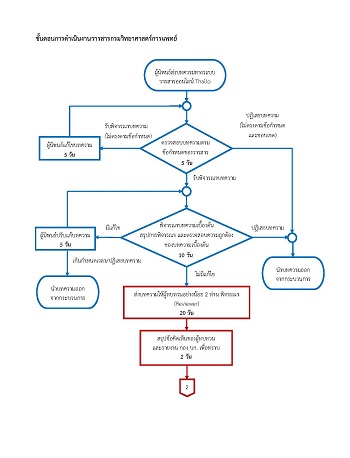กระบวนการปรุงสุกต่อการเปลี่ยนแปลงของปริมาณสารกลุ่มแคนนาบินอยด์ของใบกัญชา
กระบวนการปรุงสุกต่อการเปลี่ยนแปลงสารแคนนาบินอยด์ในใบกัญชา
คำสำคัญ:
ใบกัญชา, ตะนาวศรีก้านแดง, กระบวนการปรุงสุก, สารแคนนาบินอยด์บทคัดย่อ
การปรุงอาหารด้วยกัญชาส่งผลต่อการเพิ่มหรือลดของสารกลุ่มแคนนาบินอยด์ ทำให้อาหารมีฤทธิ์เปลี่ยนไปจึงศึกษาผลกระทบของการปรุงอาหารต่อการเปลี่ยนแปลงของสาร CBD, CBDA, Δ9–THC, Δ8–THC และ THCA ที่ผ่านกระบวนการต้ม ผัด และทอด โดยใช้ใบกัญชาสดพันธุ์ตะนาวศรีก้านแดงและใบกัญชาที่กำลังพัฒนาพันธุ์ ทั้ง 2 พันธุ์ โดยสถาบันวิจัยสมุนไพร เปรียบเทียบปริมาณสารระหว่างใบสดและใบที่ผ่านการปรุง วิเคราะห์ด้วยเทคนิค HPLC พบว่าการต้มทำให้ปริมาณสาร CBD และ Δ9–THC ในใบกัญชาเพิ่มขึ้นร้อยละ 248.18 และ 760.79 ตามลำดับ สาร CBDA และ THCA ลดลงร้อยละ 88.08 และ 88.30 ตามลำดับ พบสารในน้ำต้มเพียงเล็กน้อย การผัด CBD และ Δ9–THC เพิ่มขึ้นร้อยละ 110.12 และ 260.31 สาร CBDA และ THCA ลดลงร้อยละ 94.11 และ 56.62 ตามลำดับ การทอดทำให้ปริมาณสารลดลงจากใบสดแต่ยังพบสารในน้ำมันทอด เมื่อประเมินความเสี่ยงของ Δ9–THC จากการบริโภคอาหารกัญชา เปรียบเทียบกับค่าอ้างอิงวิกฤตจาก EFSA ที่ 1 ไมโครกรัม/กิโลกรัมน้ำหนัก พบว่าการบริโภคใบกัญชาพันธุ์ตะนาวศรีก้านแดงทั้งใบสดและใบปรุงสุกทุกวิธี 1 ใบ ให้ค่า margin of safety (MOS) ในช่วง 0.05–0.22 ซึ่งน้อยกว่า 1 แสดงว่าการบริโภคนี้ไม่ทำให้ได้รับสาร Δ9–THC เกินค่ามาตรฐาน ส่วนใบกัญชาที่กำลังพัฒนาพันธุ์ 1 ใบ ให้ค่า MOS ในช่วง 0.01–10.62 แสดงว่าการได้รับสาร Δ9–THC เกินค่ามาตรฐานหรือมีความเสี่ยงต่อสุขภาพอย่างมีนัยสำคัญ ดังนั้นในการบริโภคกัญชาควรคำนึงถึงปริมาณสารที่มีอยู่เดิมและวิธีในการปรุงเพื่อให้สามารถบริโภคได้อย่างปลอดภัย
เอกสารอ้างอิง
บังอร ศรีพานิชกุลชัย. การใช้กัญชาเพื่อประโยชน์ทางการแพทย์. ว. เภสัชศาสตร์อีสาน 2562; 15(4): 1-26.
Grand View Research. Thailand legal cannabis market size, share & trends analysis report by derivative (Marijuana, Hemp), by sources (CBD, THC), by end-use (Medical Use, Recreational Use, Industrial Use), and segment forecasts, 2022-2030. [online]; [cited 2023 Jul 20]; [10 screens]. Available from: URL: https://www.grandviewresearch.com/industry-analysis/thailand-legal-cannabismarket-report.
Fortune Business Insights. Cannabis-infused food market size, share & Industry analysis, by application (bakery, confectionery, snacks, condiments) and regional forecast, 2023-2030. [online]; [cited 2023 Jul 23]; [3 screens]. Available from: URL: https://www.fortunebusinessinsights.com/cannabis-infused-foodmarket-103167.
มาลา สร้อยสำโรง, พินท์สุดา เพชรประสม, บรรณาธิการ. กัญชากับตำรับอาหารไทย. นนทบุรี: กรมการแพทย์แผนไทยและการแพทย์ทางเลือก กระทรวงสาธารณสุข; 2564.
Barrus DG, Capogrossi KL, Cates SC, Gourdet CK, Peiper NC, Novak SP, et al. Tasty THC: promises and challenges of cannabis edibles. Methods Rep (RTI Press) 2016; 2016: 10.3768. (22 pages).
ไทยรัฐออนไลน์. ไขอาการแพ้กัญชา เนย นม ขนม สายหวานพึงระวัง เมานาน 4-6 ชั่วโมง. [ออนไลน์]. 2565; [สืบค้น 23 ก.ค. 2566]; [9 หน้า]. เข้าถึงได้ที่: URL: https://www.thairath.co.th/scoop/interview/2420986.
Wang M, Wang YH, Avula B, Radwan MM, Wanas AS, van Antwerp J, et al. Decarboxylation study of acidic cannabinoids: a novel approach using ultra-high-performance supercritical fluid chromatography/photodiode array-mass spectrometry. Cannabis Cannabinoid Res 2016; 1(1): 262-71.
ประกาศกระทรวงสาธารณสุข ฉบับที่ 438 (พ.ศ. 2565) ออกตามความในพระราชบัญญัติอาหาร พ.ศ. 2522 เรื่อง ผลิตภัณฑ์อาหารที่มีส่วนประกอบของส่วนของกัญชาหรือกัญชง (ฉบับที่ 2). ราชกิจจานุเบกษา เล่ม 139 ตอนพิเศษ 251 ง (วันที่ 21 ตุลาคม 2565). หน้า 31.
ยาใจ อภิบุณโยภาส, วินัย วนานุกูล. ภาวะพิษจากกัญชา Cannabinoids poisoning. จุลสารพิษวิทยา 2552; 17(2): 3-5.
ประกาศกรมวิชาการเกษตร เรื่อง โฆษณาคำขอให้ออกหนังสือรับรองพันธุ์พืชขึ้นทะเบียน ตามพระราชบัญญัติพันธุ์พืช พ.ศ. 2518. วันที่ 23 กรกฎาคม 2564. กรุงเทพฯ: กรมวิชาการเกษตร กระทรวงเกษตรและสหกรณ์; 2564.
European Food Safety Authority (EFSA); Arcella D, Cascio C, Mackay K. Acute human exposure assessment to tetrahydrocannabinol (Δ9-THC). EFSA J 2020; 18(1): e05953. (41 pages).
สกุลรัตน์ สมสันติสุข, อัจฉรี อินแก้ว, เสาวณีย์ วาจาสิทธิ์, สุวิมล หมวดหม๊ะ, กัญญารัตน์ เชื้อกูลชาติ, วิทวัส วังแก้วหิรัญ, และคณะ. การพัฒนาและทดสอบความถูกต้องของวิธีวิเคราะห์สารกลุ่มแคนนาบินอยด์ในนํ้ามะพร้าวโดยเทคนิค LC-MS/MS. ว กรมวิทย พ 2564; 63(3): 556-70.
Vaclavik L, Benes F, Fenclova M, Hricko J, Krmela A, Svobodova V, et al. Quantitation of cannabinoids in cannabis dried plant materials, concentrates, and oils using liquid chromatography–diode array detection technique with optional mass spectrometric detection: single-laboratory validation study, first action 2018.11. J AOAC Int 2019; 102(6): 1822-33.
Arcella D, Baines J, Boon PE, Cressey P, DiNovi M, Hambridge T, et al. Chapter 6 Dietary exposure assessment for chemicals in food. In: Sheffer M, editor. Principles and methods for the risk assessment of chemicals in food. 2nd ed. Canada: WHO Press; 2020. p. 1-175.
สำนักงานมาตรฐานสินค้าเกษตรและอาหารแห่งชาติ. ฐานข้อมูลปริมาณอาหารที่คนไทยบริโภค. [ออนไลน์].; [สืบค้น 27 ก.ค. 2566]; [1 หน้า]. เข้าถึงได้ที่: URL: http://consumption.acfs.go.th/main;jsessionid=6F6A437752A47CF9F56D314DEB0BC098.
Burstein SH. The cannabinoid acids: nonpsychoactive derivatives with therapeutic potential. Pharmacol Ther 1999; 82(1): 87-96.
Perrotin-Brunel H, Buijs W, Van Spronsen J, Van Roosmalen MJ, Peters CJ, Verpoorte R, et al. Decarboxylation of Δ9-tetrahydrocannabinol: kinetics and molecular modeling. J Mol Struct 2011; 987(1-3): 67-73.
Dussy FE, Hamberg C, Luginbühl M, Schwerzmann T, Briellmann TA. Isolation of Δ9-THCA-A from hemp and analytical aspects concerning the determination of Δ9-THC in cannabis products. Forensic Sci Int 2005; 149(1): 3-10.
Repka MA, Munjal M, ElSohly MA, Ross SA. Temperature stability and bioadhesive properties of Δ9-tetrahydrocannabinol incorporated hydroxypropylcellulose polymer matrix systems. Drug Dev Ind Pharm 2006; 32(1): 21-32.
Seo C, Jeong M, Lee S, Kim EJ, Rho S, Cho M, et al. Thermal decarboxylation of acidic cannabinoids in Cannabis species: identification of transformed cannabinoids by UHPLC-Q/TOF–MS. J Anal Sci Technol 2022; 13: 42. (12 pages).
Rosenkrantz H, Thompson GR, Braude MC. Oral and parenteral formulations of marijuana constituents. J Pharm Sci 1972; 61(7): 1106-12.
Garrett ER, Hunt CA. Physiochemical properties, solubility, and protein binding of Δ9-tetrahydrocannabinol. J Pharm Sci 1974; 63(7): 1056-64.
Grifoni L, Vanti G, Donato R, Sacco C, Bilia AR. Promising nanocarriers to enhance solubility and bioavailability of cannabidiol for a plethora of therapeutic opportunities. Molecules 2022; 27(18): 6070. (22 pages).
Triesch N, Vijayakumar N, Weigel S, These A. Cannabinoid contents in hemp teas and estimation of their transfer into tea infusions. Food Addit Contam Part A 2023; 40(7): 890-901.
King D, Bhatarah P, Duffy P, Yates A, O’Sullivan SE. Health guidance levels for THC in CBD products: safety assessment & regulatory recommendations. [online]. [cited 2023 Aug 1]; [40 screens]. Available from: URL: https://theaci.co.uk/wp-content/uploads/2021/03/Joint-report-CMC-ACI-CPDRG-Health-Guidance-Levels-for-THC-in-CBD-products.pdf.
Gibson K. Unlicensed weed tainted with E. coli, lead and salmonella, study finds. [online]. 2022; [cited 2023 Aug 1]; [1 screen]. Available from: URL: https://www.cbsnews.com/news/cannabis-unlicensed-weed-e-coli-lead-andsalmonella-study-finds/.

ดาวน์โหลด
เผยแพร่แล้ว
รูปแบบการอ้างอิง
ฉบับ
ประเภทบทความ
สัญญาอนุญาต
ลิขสิทธิ์ (c) 2024 วารสารกรมวิทยาศาสตร์การแพทย์

อนุญาตภายใต้เงื่อนไข Creative Commons Attribution-NonCommercial-NoDerivatives 4.0 International License.



